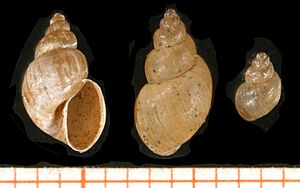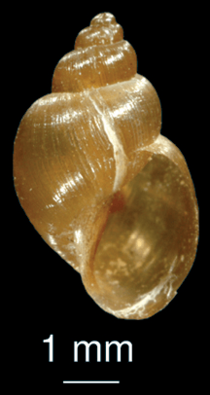Galba truncatula facts for kids
Quick facts for kids Galba truncatula |
|
|---|---|
 |
|
| Scale bar in mm | |
| Conservation status | |
| Scientific classification | |
| Genus: |
Galba (gastropod)
|
| Species: |
truncatula
|
| Synonyms | |
|
|
The Galba truncatula is a small, air-breathing freshwater snail. It's a type of mollusk that lives in water and belongs to the pond snail family, Lymnaeidae. For a long time, this snail was known by the name Lymnaea truncatula.
This snail is important because it can carry tiny parasites that cause a disease called fascioliasis. This disease can affect both animals and sometimes humans.
Contents
Where Galba truncatula Lives
Scientists believe that Galba truncatula first came from Europe. But over time, it has spread to many other parts of the world. Today, you can find this snail in almost all European countries. This includes islands like Corsica, Malta, the Azores, and the Canary Islands.
Even though this snail is found worldwide, it's hard to find exact maps showing where it lives everywhere. Most reports are based on how the snail looks. It's harder to confirm its presence in non-European areas using special genetic tests.
Galba truncatula has also been found in North America, South America, parts of Africa, and Asia. In South America, its presence has been confirmed by genetic tests in countries like Bolivia, Peru, Argentina, Chile, and Venezuela. In Africa, it's mostly found in the northern parts, but also in South Africa, Ethiopia, Kenya, and Tanzania. In Asia, it's found in Russia, Iran, Pakistan, and India.
What Galba truncatula Looks Like
The shell of the Galba truncatula snail is usually about 5 to 10 millimeters (about 0.2 to 0.4 inches) tall. Its width is around 2.5 to 6 millimeters (about 0.1 to 0.24 inches). The longest shell ever found was 12 millimeters (about 0.47 inches) tall.
The shell has whorls that look like steps. The central part of the shell, called the columella, is folded.
The snail's tentacles are wider at their base, and its eyes are small. The top part of its body, called the mantle, has pale, whitish spots. These spots make the shell look lighter when you see the living snail.
There are two other snail species, Galba neotropica and Galba schirazensis, that look very similar to Galba truncatula. Because they look so alike, it can be hard to tell them apart just by looking. To be sure, scientists often need to use special genetic tests. Sometimes, these different snail species can even live together in the same places.
How Galba truncatula Lives
Habitat
Galba truncatula can live in both temporary and permanent freshwater places. You can often find it in shallow, well-aerated water. This includes marshes, ponds, lakes, streams, rivers, and even water ditches. In France, the number of these snails is going down because their homes are being changed by modern farming methods.
If the water body is large, the snail usually stays at the edge where the water meets the land. Sometimes, it can even be found on the mud outside the water. These snails can be very common and live in large groups. They also tend to live near humans, often found in areas close to towns and farms.
Galba truncatula is an amazing creature because it can survive long dry periods. It does this by going into a resting state called aestivation. During this time, it can stay alive in mud for 6 weeks to 4.5 months without water. In labs, some snails have even survived for over a year in dishes without water!
This snail prefers water that is slightly alkaline (pH 7.0 to 9.6). It also needs a certain amount of calcium in the water. Galba truncatula can even live in very high places, like the Northern Bolivian Altiplano, which is between 3,800 and 4,100 meters (about 12,500 to 13,500 feet) high.
Feeding Habits
Galba truncatula snails eat algae (tiny water plants) and parts of other plants, both fresh and decaying.
Life Cycle
In Europe, these snails usually have two generations (or groups of babies) born each year. The snails themselves can live for up to two years. If there's a lot of rain, they might even have three generations in a single year.
They hatch from eggs. The egg clusters are usually round or oval-shaped, even if they contain many eggs. Each cluster typically has between 2 and 15 eggs.
Parasites
Galba truncatula can act as an "intermediate host" for certain tiny parasites. This means the parasites live inside the snail for a part of their life cycle before moving on to another animal. These parasites include:
- Fasciola hepatica
- Fasciola gigantica
- Fascioloides magna
- Haplometra cylindracea
- Plagiorchis spp.
- Opisthioglyphe spp.
- Calicophoron daubneyi
- Muellerius capillaris
Because this snail can carry these parasites, it plays a role in spreading diseases like fascioliasis to animals and sometimes to humans.



